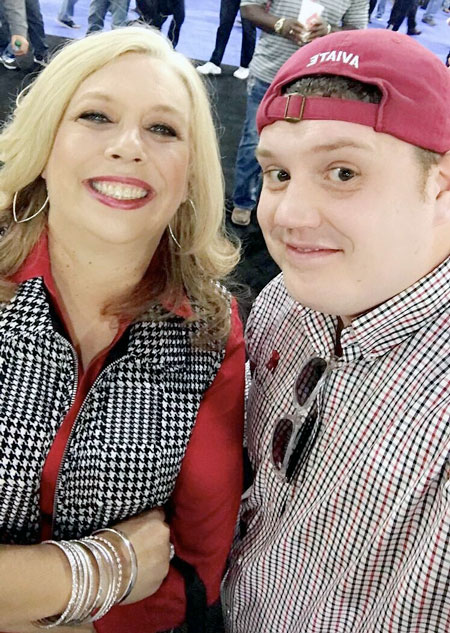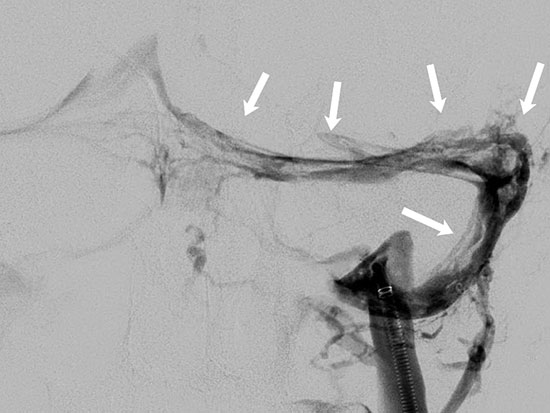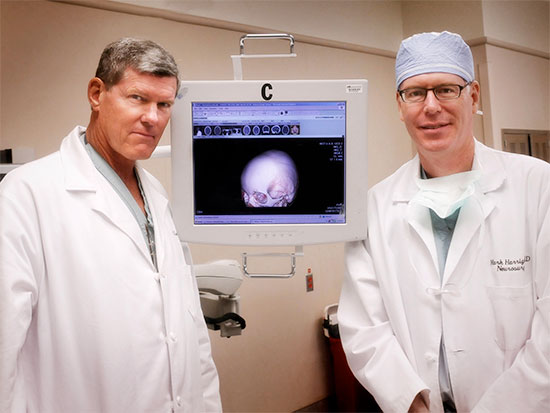Written by: Anna Waters
Media contact: Bob Shepard, bshep@uab.edu
 Michel attended the 2016 SEC Championship Game to root for the Crimson Tide.Die-hard University of Alabama football fan Michel Thomas would not have missed the 2016 SEC championship game — the Florida Gators against his Crimson Tide — for anything. Although he had spent the days before the game suffering from debilitating headaches and would spend the week after too nauseated to participate in final exams or project meetings with his classmates, Thomas made it to the Georgia Dome on Dec. 3, 2016, with his co-worker of 14 years, Tracy Taylor, R.N., nurse to UAB neurosurgeon Mark Harrigan, M.D.
Michel attended the 2016 SEC Championship Game to root for the Crimson Tide.Die-hard University of Alabama football fan Michel Thomas would not have missed the 2016 SEC championship game — the Florida Gators against his Crimson Tide — for anything. Although he had spent the days before the game suffering from debilitating headaches and would spend the week after too nauseated to participate in final exams or project meetings with his classmates, Thomas made it to the Georgia Dome on Dec. 3, 2016, with his co-worker of 14 years, Tracy Taylor, R.N., nurse to UAB neurosurgeon Mark Harrigan, M.D.
Unbeknownst to both of them, Thomas attended that game with a blood clot in his brain, and Harrigan would later be the one to remove it.
“I will say I was pretty miserable during the game,” said Thomas, a business officer in the UAB Department of Neurosurgery. “I remember cheering during the first quarter during a turnover and thinking my head was going to explode.”
After nearly a week of constant headaches and nausea, Thomas — a UAB alumnus and a Master of Science in Health Informatics student in the UAB School of Health Professions — finally sought treatment at UAB Medicine Urgent Care for what he thought were common migraines.
“That Monday, after I quit throwing up, I remember getting into the car to go to work, realizing I didn’t have my wallet, going back inside and then going back to the car just to realize I still didn’t have my wallet,” Thomas said. “By that point, it was day five, and I was still having these headaches. At the insistence of my primary care physician, Dr. Amy Lejeune, I decided to go to urgent care, thinking that they would just give me a migraine cocktail so I could go back to work and then go home.”
Andrew Allen, M.D., the doctor Thomas saw at urgent care, says he could tell something was seriously wrong the moment he walked in.
“Michel said he went to an Alabama football game the weekend before, and it seems like his clot was expanding during that game,” Allen said. “He was complaining of a lot of intermittent headaches and vomiting, which was a red flag for me. Initially, the intensity and localization of those headaches made me concerned about an aneurysm.”
Allen immediately sent Thomas to the emergency room, where a CT scan showed not an aneurysm but a blood clot. That night, Thomas was admitted to the hospital under the care of Winfield Fisher, III, M.D., a UAB neurosurgeon with whom Thomas worked.
At the hospital, Thomas learned that his most severe headaches and vomiting, as well as his current, persisting symptoms, were due to a brain bleed and a blood clot in his dural venous sinuses, which drain blood from the brain. Intracranial venous sinus thrombosis, as it is called, is a rare disorder that, in this case, was caused by a factor V Leiden deficiency, a hereditary hypercoagulability disorder.
 “The symptoms of my condition were similar to those of an aneurysm; but a lot of people who have this kind of clot actually have strokes, so I got lucky with a bleed instead,” Thomas said. “Either way, they’re bad; but the urgent care doctor got me to the ER quickly.”
“The symptoms of my condition were similar to those of an aneurysm; but a lot of people who have this kind of clot actually have strokes, so I got lucky with a bleed instead,” Thomas said. “Either way, they’re bad; but the urgent care doctor got me to the ER quickly.”
Angiogram images show blood vessels following thrombectomy and treatment with blood thinners. The arrows indicate scattered blood clots present throughout the venous system, which were diminished in size and extent after treatment.Fisher initially treated Thomas’ blood clots with blood thinners, hydration and pain medication, which Fisher hoped would dissolve the blood clot and ease Thomas’ symptoms. Because Thomas was in the hospital during finals, the School of Health Professions allowed him to take one of his finals on paper rather than on a computer screen, which caused him fewer headaches. However, even after he returned to work part time at the end of December, his headaches were still severe and frequent. It was then that he went back to the ER and started to consider surgery to remove the clot.
The second time Thomas was admitted to the hospital, he was met by Harrigan, who suggested a thrombectomy, a procedure in which neurosurgeons lead a plastic catheter from the femoral vein in the leg to the venous sinuses in the head and then pull the blood clot out using a mechanical aspirator.
“This technique has come on the scene in the last six or eight years as a therapy for acute stroke, but we use it for intracranial venous sinus thrombosis as well,” Harrigan said. “That system has certain design features that make it very useful for Michel’s condition.”
Thomas says his experience as a Department of Neurosurgery staff member helped him navigate the ins and outs of a neurosurgical procedure but didn’t prepare him for the experience of being the one in the hospital bed.
“I already knew a little bit about the process from working in the hospital and directly with neurosurgeons, but it’s different when you’re the patient,” Thomas said.
Harrigan performed Thomas’ thrombectomy on New Year’s Eve, removing much of the blood clot and alleviating some of Thomas’ symptoms.
 UAB neurosurgeons Winfield Fisher and Mark Harrigan.However, after three months, Thomas was still suffering from severe, frequent headaches and light sensitivity that were interfering with his life. Part of the blood clot was still present in his venous sinuses, and the same pain that had followed him since December was making it difficult for him to work or go to school full time. When he discussed these ongoing symptoms with Harrigan, they began to consider another thrombectomy to remove the remainder of the blood clot.
UAB neurosurgeons Winfield Fisher and Mark Harrigan.However, after three months, Thomas was still suffering from severe, frequent headaches and light sensitivity that were interfering with his life. Part of the blood clot was still present in his venous sinuses, and the same pain that had followed him since December was making it difficult for him to work or go to school full time. When he discussed these ongoing symptoms with Harrigan, they began to consider another thrombectomy to remove the remainder of the blood clot.
“We have to rely on his opinion,” Harrigan said. “In the old days, we used to reserve this for people who were getting really sick, like going into a coma or things like that, and in that case, the neurologic change is more objective. But with the bad headaches Michel was having, it’s subjective. We had to rely on him to tell us how bad his headaches were.”
Finally, Thomas’ second thrombectomy, on March 6, 2017, removed the entire clot and relieved most of his symptoms.
“We used the largest of the catheters, called an ACE68,” Harrigan said. “It’s like a great big straw, but bigger and longer.”
Thomas says he has felt markedly better since his second surgery and has resumed his work and classes full time.
“I never fell behind in academics, thanks to the School of Health Professions, and I’m so grateful to them for working with me through all this,” Thomas said. “My co-workers were also just really supportive when I had to stay home or leave for doctors’ appointments, and I know that would have been the case even if I weren’t being treated by the faculty members in my department.”
Eta S. Berner, Ed.D., one of Thomas’ professors in the School of Health Professions, says she was impressed by his diligence in completing his coursework while he was in and out of the hospital.
| “This is a disease that seems to affect younger people more than older people. We’ve done a lot of these procedures on people in their 20s or 30s.” |
“Michel was very conscientious in making up the work, even though he was still sick and had to manage the regular course workload as well,” Berner said. “He did very well in the course, even with all that stress.”
While Thomas’ quality of life has been drastically improved, he still sees several UAB specialists to manage his headaches and is aware that this doesn’t mean he will remain blood-clot-free.
“He’s young; but he’s still at risk for recurrence of the blood clots in his head and for developing blood clots in other veins in his body, too,” Harrigan said. “This is a disease that seems to affect younger people more than older people. We’ve done a lot of these procedures on people in their 20s or 30s.”
Harrigan explained that, while treating a co-worker is a different experience for him, he’s thankful to have had the opportunity to spend more time with Thomas during his recovery, and that Thomas has returned to work.
“Because Michel is a colleague and friend, I see him a lot more frequently than I see other patients,” Harrigan said. “As his neurosurgeon, it is rewarding to see Michel successfully back in his daily routine.”